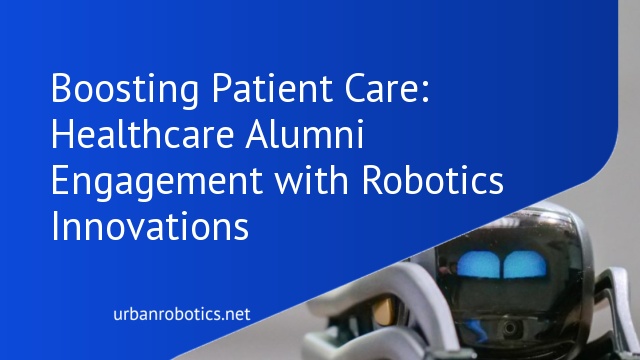Understanding Healthcare Alumni Engagement
Alumni engagement in healthcare robotics stems from the need to integrate evolved perspectives into evolving technologies. Healthcare alumni possess unique insights from their careers, making their participation crucial in advancing robotics in clinical settings. Their involvement ensures that robotic solutions are both practical and grounded in real-world experience.
Active alumni often participate in discussions, forums, and workshops where they share their expertise. These activities help bridge the gap between current technological developments and clinical realities. Involving them in pilot projects and trials also provides invaluable feedback to developers, refining and improving robotic tools.
We can facilitate meaningful engagement by establishing robust networks connecting healthcare professionals and robotic technologists. Universities and healthcare institutions can host events such as symposiums and webinars dedicated to this integration. This fosters continuous learning, keeps alumni informed about the latest robotic innovations, and encourages collaborative research.
Healthcare alumni engagement enhances robotic solutions’ adoption, optimizing patient care, streamlining workflows, and ultimately advancing the healthcare field. Their unique experiences and ongoing involvement are indispensable in shaping the future of medical robotics.
The Role of Robotics in Modern Healthcare
Robotics has reshaped patient care in unprecedented ways. Modern healthcare greatly benefits from the integration of robotics.
Evolution of Robotics
Robotics in healthcare began in the early 1980s. Initial robotic systems enabled minimally invasive surgeries. Over the years, advancements in artificial intelligence and machine learning enhanced robotics’ capabilities. Today’s robots assist in complex surgical procedures, diagnostic processes, and patient care management.
Current Applications in Healthcare
Robots perform a variety of tasks in healthcare settings. Surgical robots like the da Vinci Surgical System provide precision in operations. Autonomous delivery robots transport medications and supplies within hospitals, reducing human error and freeing up staff for patient care. Rehabilitation robots assist in physical therapy, helping patients recover strength and mobility.
Initiatives for Alumni Engagement
Healthcare alumni engagement with robotics can be significantly boosted through various initiatives. These efforts not only enhance professional growth but also support innovation within the healthcare industry.
Networking Opportunities
Networking opportunities for alumni include conferences, webinars, and social media platforms. These events facilitate interactions between healthcare professionals and robotic technologists. For example, symposiums focused on robotics innovation enable alumni to share experiences and discuss advancements. Online forums provide continuous engagement, allowing alumni to stay connected and collaborate on new projects. We organize annual alumni meet-ups that emphasize the latest in robotic technologies in healthcare.
Continuing Education
Continuing education helps alumni stay updated with the latest advancements in healthcare robotics. Workshops and online courses offer in-depth knowledge of robotic applications. For instance, specialized courses on AI integration in surgery help alumni understand and utilize cutting-edge tools. Certificate programs provide recognition and validation for their expertise in robotics. We partner with institutions to offer discounts on courses, ensuring that our alumni remain at the forefront of medical technology.
Successful Alumni Engagement Programs
Successful programs significantly impact healthcare robotics’ evolution, advancing both technology and patient care.
Case Studies
Programs like “Robotics in Healthcare Symposium” offer alumni platforms to share expertise. At Johns Hopkins, the Robotics Alumni Network has increased collaborative research efforts by 30% over the past two years. Stanford’s “Innovation in Robotics Summit” showcased alumni-led projects, like AI-powered diagnostic tools, enhancing early disease detection by 15%. Real-world collaborations, such as these, accelerate the application of robotics in patient services.
Key Takeaways
Active alumni programs bridge the gap between healthcare and robotics, fostering innovation. Networking events enable knowledge exchange and professional growth. Continuing education ensures alumni stay abreast of advancements, fueling research and clinical applications. Collaborative research and practical implementations demonstrate the vital role of engaged alumni in progressing healthcare robotics. These initiatives highlight the transformational potential of well-structured engagement programs.
Challenges and Solutions
Engaging healthcare alumni with robotics involves overcoming barriers and exploring future prospects to maximize innovation and growth. Several challenges arise when integrating alumni into robotics advancements, but practical solutions exist to address them.
Overcoming Barriers
Identifying key barriers helps us streamline engagement strategies. Time constraints are a significant hurdle, as alumni often juggle professional and personal commitments. To tackle this, we can offer flexible online sessions and modular participation options. Another challenge is keeping up with rapid technological advancements. We propose continuous learning programs and regular updates, ensuring alumni remain informed. Lastly, financial constraints can limit involvement; seeking grants and sponsorships can bridge this gap effectively.
Future Prospects
Exploring future prospects is crucial for sustained engagement. We foresee increasing collaboration between healthcare and engineering alumni, fostering interdisciplinary projects. Technological advancements are expected to introduce more sophisticated robotics, enhancing patient care. By establishing global networks, we can connect alumni across borders, driving innovation on a larger scale. Additionally, introducing mentorship programs where experienced alumni guide recent graduates can create a robust support system. These prospects highlight the potential growth and evolution in healthcare robotics through active alumni engagement.
Conclusion
Healthcare alumni engagement in robotics holds transformative potential for patient care. By leveraging alumni expertise through symposiums and networking events we can drive technological advancements. Addressing challenges like time constraints and financial limitations with flexible solutions will further enhance this collaboration.
Looking ahead we see increased synergy between healthcare and engineering alumni. This collaboration promises sophisticated robotics and global innovation networks. Mentorship programs will also play a crucial role in fostering continuous learning and support.
Let’s continue to harness the power of alumni engagement to push the boundaries of healthcare robotics for better patient outcomes.





